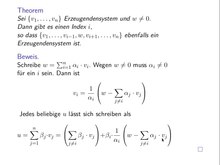Dimension (math)
The dimension is a concept in mathematics , which is essentially the number of degrees of freedom of movement in a particular area designated.
The concept of dimension occurs in a variety of contexts. No single mathematical concept is able to define the dimension satisfactorily for all situations, which is why different dimension terms exist for different rooms.
Hamel dimension (dimension of a vector space)
The best known is the dimension of a vector space , also called the Hamel dimension . It is equal to the thickness of a basis of vector space. The following statements are equivalent to this:
- The dimension is equal to the power of a minimal generating system .
- The dimension is equal to the thickness of a maximum system of linearly independent vectors.
For example, the geometrically clear Euclidean 3-space has the dimension 3 (length, width, height). The Euclidean plane has dimension 2, the number line has dimension 1, and the point has dimension 0. In general, the vector space has the dimension .
Vector spaces that do not have a finite generating system can also be assigned the power of a minimal generating system as a dimension; it is then an infinite cardinal number .
The word “Hamel basis” is mainly used for infinitely dimensional vector spaces because Georg Hamel was the first to prove the existence of a basis in this case too (with the help of the well-order theorem, i.e. the axiom of choice ).
Hilbert space dimension
Every Hilbert space has an orthonormal basis . Only when it has a finite number of elements is it a Hamel base in the sense defined above. One can show that every two orthonormal bases have the same number of elements, and thus it is possible to define the dimension of the Hilbert space as the cardinality of an orthonormal basis; this is also a cardinal number . This cardinal number is sufficient to completely classify Hilbert spaces: for every cardinal number there is exactly one Hilbert space, except for isomorphism , which has an orthonormal basis of the corresponding cardinality.
Example: The Hilbert space of square integrable functions on [0, 1] has Hilbert space dimension - but the Hamel dimension is really larger.
Dimension of a manifold
In addition, the dimension of a manifold is also clearly understandable. By definition, every point of a manifold has a neighborhood that is homeomorphic to -dimensional Euclidean space; this is called the dimension of the manifold. In order to prevent the dimension from depending on the choice of the point, the dimension term is usually only used for connected manifolds or manifolds are defined from the start in such a way that the model space and thus the dimension are the same everywhere.
Well-known two-dimensional manifolds are the surface of a sphere or the Möbius strip .
Dimension of a metric space
The Hausdorff dimension makes it possible to assign a dimension to each subset of a metric space. The Hausdorff dimension is the infimum over all for which the Hausdorff dimension is zero. This is equivalent to the supremum over all for whom the Hausdorff measure is infinite.
Dimension of a simplicial complex
The dimension of an abstract simplex that contains corners is defined as . The dimension of the simplicial complex is defined as the maximum of the dimension of all simplices occurring in . If the dimension of the simplices is not restricted, then is called infinite-dimensional.
Chain length as a dimension
The dimension of a vector space is equal to the maximum length (number of inclusions) of a chain of subspaces contained within one another. The view of the dimension as chain length allows a generalization to other structures.
For example, the Krull dimension of a commutative ring is defined as the maximum length of a chain of interconnected prime ideals minus 1.
Likewise, the dimension of a manifold is the maximum length of a chain of manifolds contained in one another, in which each link of the chain is the edge of a subset of the previous one. For example, the edge of the globe is the surface of the earth; The border of their subset Germany is the state border; The edge of a certain border section are the two end points - since there is no longer chain, the globe has dimension 3. Since inclusion and edge formation are always defined, this provides a dimension term for every topological space (so-called inductive dimension ). A more common topological dimension concept is the Lebesgue cover dimension .
Topological dimension
A topological space has the dimension if is the smallest natural number such that for every open cover there is a finer open cover , so that every point from lies in at most the sets . If there is no such thing , it is called of infinite dimension.
In addition, the so-called inductive dimension is used in the topology as an alternative to Lebesgue's coverage dimension :
Fractal dimension
In addition to the integer dimensions specified so far, we also know generalized, rational or real-numbered dimension terms , with the help of which so-called fractals can be compared.
Algebraic Geometry
See algebraic variety and dimension (commutative algebra) (Krull dimension).
Order dimension
The concept of the dimension of order is based on Dushnik-Miller's theorem , according to which every partial order on a set can be represented as the intersection of linear orders . A partially ordered set is then assigned the smallest thickness of such a representative system of linear order relations as the ordering dimension .



![L ^ {2} ([0,1])](https://wikimedia.org/api/rest_v1/media/math/render/svg/13c2586b254365ca72d662d9e6485fdee8026912)











